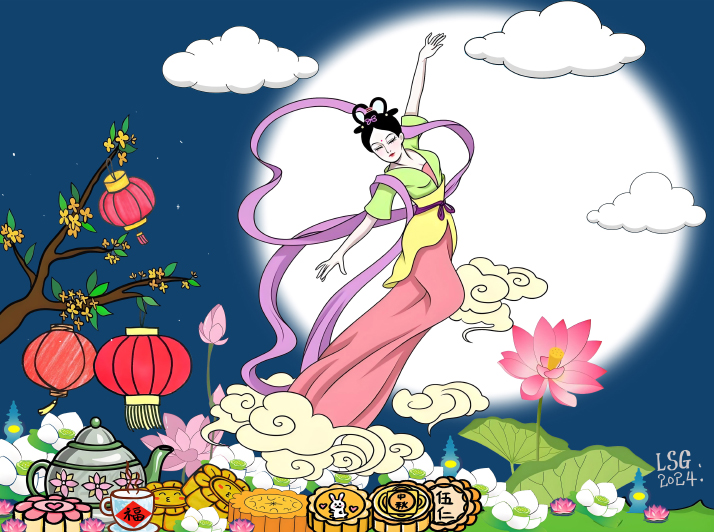| Lifestyle |
| Beneath the full moon | |
|
|
 (ILLUSTRATION BY LI SHIGONG)
Mid-Autumn Festival, which falls on the 15th day of the eighth month on the traditional Chinese calendar—on September 17 this year, has always been my favorite holiday celebration since I arrived in China in 1993. Even after all these years, it holds a special place in my heart, and each year I eagerly anticipate its arrival. The festival stands apart from other holidays because of its timing—just as the summer heat fades and the crisp, refreshing autumn breeze begins. It's a brief time window when the weather is perfect, allowing people to enjoy outdoor activities before the biting cold of winter sets in. In China, this season invites everyone to embrace the beauty of the outdoors, whether it be taking a stroll in a park or planning a short weekend getaway. What makes the Mid-Autumn Festival even more delightful is the tradition of sharing mooncakes. Every year, families and friends come together to eat these round pastries, which symbolize unity and completeness. The variety of fillings—from sweet bean paste to salted egg yolks, dried fruits and nuts—ensures a flavor for everyone. When I first experienced the festival, I was immediately struck by how these little cakes became the centerpiece of family reunions and social gatherings. During the rapid growth of China's economy, mooncakes became much more than just a simple pastry. In 1996, I remember visiting a store in Shijiazhuang, capital of Hebei Province in north China, and seeing a mooncake package with a price tag of 80,000 yuan (around $9,500 at the exchange rate at the time). It was displayed like a rare museum piece, and I couldn't help but marvel at how a beloved tradition had been transformed into something so extravagant. It was fascinating to witness how a festive delicacy evolved into a high-priced commodity, placing it out of reach for many. The trend became so extreme that the government eventually stepped in to curb the sky-high prices, restoring balance to the market and reining in the mooncake extravagance. In recent years, mooncake sales have continued to soar, reflecting people's increasing purchasing power. In 2023 alone, mooncake sales in China reached a staggering 27.13 billion yuan ($3.8 billion). With innovative flavors and online sales channels, the mooncake market shows no signs of slowing down. By 2025, experts predict that mooncake sales will hit 33.28 billion yuan ($4.7 billion) during the festival period. These numbers are impressive, but they also highlight how the Mid-Autumn Festival has become a commercial phenomenon, driven by a deep cultural tradition that remains central to Chinese life. Beyond the mooncake madness, what makes this festival so special is its deep-rooted history and meaning. The festival goes back over 3,000 years, and while the celebrations have evolved, the core concepts of family, gratitude and prayer remain strong. One of the most beautiful traditions associated with this festival is moon worship, tied to the legendary tale of Chang'e, the Moon Goddess. Her story is one of love, sacrifice and immortality, and it has been passed down through generations, adding a sense of mysticism to the festival. During the Mid-Autumn Festival, offerings are still made to the Moon Goddess, and families gather to admire the moon, believed to be the fullest and brightest on this special night. Despite all the changes over the years, what truly endures is the sense of reunion that this festival brings. It's about more than just mooncakes or lanterns—it's about people coming together, whether it be family, friends or colleagues. For me, this feeling of togetherness is what makes the Mid-Autumn Festival so enchanting. Even after decades of living in China, I still find myself mesmerized by the magic of this festival. It's a celebration of the moon, the harvest, and most importantly, human connection. Every year, as I savor a mooncake and gaze up at the full moon, I am reminded of how precious these moments of unity and reflection are. Whether it's a simple gathering with family or a lavish celebration, the essence of the Mid-Autumn Festival remains the same—it's a time to cherish the people around you and appreciate the beauty of the world, both near and far. BR The author is a Pakistani anthropologist living in Beijing Copyedited by Elsbeth van Paridon Comments to yanwei@cicgamericas.com |
|
||||||||||||||||||||||||||||
|